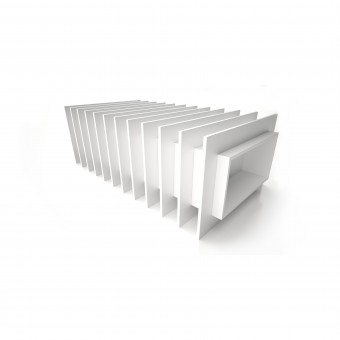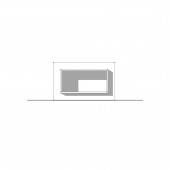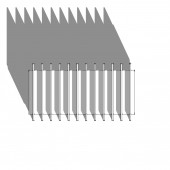
| THE AWARD |
| CATEGORIES |
| REGISTRATION |
| SUBMIT YOUR WORK |
| ENTRY INSTRUCTIONS |
| TERMS & CONDITIONS |
| PUBLICATIONS |
| DATES & FEES |
| METHODOLOGY |
| CONTACT |
| WINNERS |
| PRESS ROOM |
| GET INVOLVED |
| DESIGN PRIZE |
| DESIGN STORE |
| THE AWARD | JURY | CATEGORIES | REGISTRATION | PRESS | WINNERS | PUBLICATIONS | ENTRY INSTRUCTIONS |
Get Your Feet Off My Coffee Table! Coffee Table by James Cornetet |
Home > Winners > Design #23294 >Interview |
 |
|
FS: What is the main principle, idea and inspiration behind your design?
JC: The primary assumption that I had to make before realizing the design of this coffee table, was that there was no table top. Once that constraint was eliminated, it provided me the freedom to redefine the typology of the table. Everything that designers previously thought to be true about the table in its essence, has been redefined by this piece.
FS: What has been your main focus in designing this work? Especially what did you want to achieve?
JC: I wanted to produce a table that was not only functional, but embraced everyday use, while still maintaining the simplicity and beauty of a piece of sculpture. The table is a datum for living, the juxtaposition of the clutter against the clarity of the object, only strengthens its beauty.
FS: What are your future plans for this award winning design?
JC: I am currently attempting to commercialize the design, and find an international audience.
FS: How long did it take you to design this particular concept?
JC: 3 months from sketch to prototype.
FS: Why did you design this particular concept? Was this design commissioned or did you decide to pursuit an inspiration?
JC: This particular design was not commissioned, and was merely a creative excercise.
FS: Is your design being produced or used by another company, or do you plan to sell or lease the production rights or do you intent to produce your work yourself?
JC: I am currently producing the work my self, but would like to sell/lease the production rights.
FS: Where there any other designs and/or designers that helped the influence the design of your work?
JC: No.
FS: Who is the target customer for his design?
JC: Anybody who appreciates function and beauty.
FS: What sets this design apart from other similar or resembling concepts?
JC: The design is unlike any coffee table to come before it. It avoids stylistic fetishisms in favor of a design that addresses the true needs of the end user. That is a table that embraces everyday use.
FS: How did you come up with the name for this design? What does it mean?
JC: After a weekend of entertaining guests at our house, we noticed that one of the guests had left a glass of water on our Carrara Marble nightstand that we had just purchased. Upset over the newly spotted table, I began thinking why can't designers design furniture that can only be used in the manner it is intended to be used. I sat on the couch pondering this idea, when my wife walked into the living room and scolded me for resting my feet on a chair. "Chairs are not for feet" she proclaimed. I replied "it's not like I'm resting my feet on the table." I thought about the comment for a minute, thinking about how I hate it when guests rest their feet on a coffee table. I quickly sketched what I presumed to be the most uncomfortable table for someone to rest their feet on. I stared at the sketch in amusement, writing "get your feet off my coffee table!" The final design emerged from an understanding that the design of the coffee table should embrace function and discourage misuse. The name of the table is a vestige of that moment.
FS: Which design tools did you use when you were working on this project?
JC: Sketches, lots of sketches. The graphics were produced using Sketchup, FormZ, Adobe Illustrator & Photoshop, and Maxwell Render. The fabrication drawings were produced using Autodesk's Revit.
FS: What is the most unique aspect of your design?
JC: Unlike most table designs, this piece maintains its showroom aesthetic while embracing the clutter of everyday life.
FS: Who did you collaborate with for this design? Did you work with people with technical / specialized skills?
JC: No.
FS: What is the role of technology in this particular design?
JC: The first prototype was completed shortly after winning the A'Design Award. The prototype is constructed of Corian, and the pieces are precision crafted using CNC technology. The efficient design of the table, results in less than 10% construction waste during the fabrication and assembly of the table, maximizing the usage of two Corian 1/2" sheets. Corian enables the table to be constructed out of smaller components in order to simplify the fabrication process, while maintaining the monolithic quality of the design. Looking as if it were carved out of a solid block of marble.
FS: Is your design influenced by data or analytical research in any way? What kind of research did you conduct for making this design?
JC: I studied the dimensions and proportions of some of the 'Classic' coffee table designs of the past. Particularly Mies van der Rohe, and the designs of Charles and Ray Eames.
FS: What are some of the challenges you faced during the design/realization of your concept?
JC: Simplifying the fabrication process by far was the most challenging aspect of realizing the concept, as well as learning how to adequately protect intellectual property.
FS: How did you decide to submit your design to an international design competition?
JC: I knew that the design was special when I built a full scale model of the design out of foam, and decided that I needed to enter it in a furniture design awards program in order to gain more exposure.
FS: What did you learn or how did you improve yourself during the designing of this work?
JC: The power of simplicity and restraint. I shared the design with a number of designers that I work with, and each designer wanted to complicate the design by adding extra functions such as drawers, hardware, etc, but I resisted the temptation and instead continued to simplify the design down to its core components.
FS: Any other things you would like to cover that have not been covered in these questions?
JC: The design of the get your feet off my coffee table questions the norms associated with the typology of the table. My favorite moment is when people encounter it for the first time. Unfamiliar with how to use such a table, they always look puzzled, and then ask: , "When will the glass top be finished?" I smile and politely respond: "There is no glass top, this is the finished design." The fact that most people do not consider the table to be finished is proof that I had succeeded in my quest to redefine the typology of the coffee table.
FS: Thank you for providing us with this opportunity to interview you.
A' Design Award and Competitions grants rights to press members and bloggers to use parts of this interview. This interview is provided as it is; DesignPRWire and A' Design Award and Competitions cannot be held responsible for the answers given by participating designers.
| SOCIAL |
| + Add to Likes / Favorites | Send to My Email | Comment | View Press-Release |





